Every few months, Google rolls out major content updates designed to pair users with the best resources on the internet. But with each release, Google’s perception of what is rank-worthy shifts.
What could have ranked first place a few months ago might be eating dust at the bottom of the SERPs today.
That’s why marketers need to adapt to the changes, discard outdated SEO practices, and stick with strategies that can withstand any algorithmic blow.
One such strategy is keyword clustering.
In this article, I’ll walk you through what keyword clustering is, the benefits you should expect, and how to implement it effectively for better rankings.
What Is Keyword Clustering?
Keyword clustering is the act of grouping keywords that share the same search intent or meaning. This group of related keywords is what is called a keyword cluster.
Though these search terms are technically different, a keyword cluster categorizes them as variants of a single search query and targets them in one piece of content.
Here’s an example:
Once upon a time, if you wanted to rank for the following keywords, you would create different pages for each one of them, giving you a total of four blog posts:
- What is an email list?
- How to build an email list
- Grow email list fast
- Tips for email list building
But anyone searching for “how to build an email” or “tips for email list building” is asking the same question, just phrased differently. And when you type them into Google’s search bar, they bring up similar results:
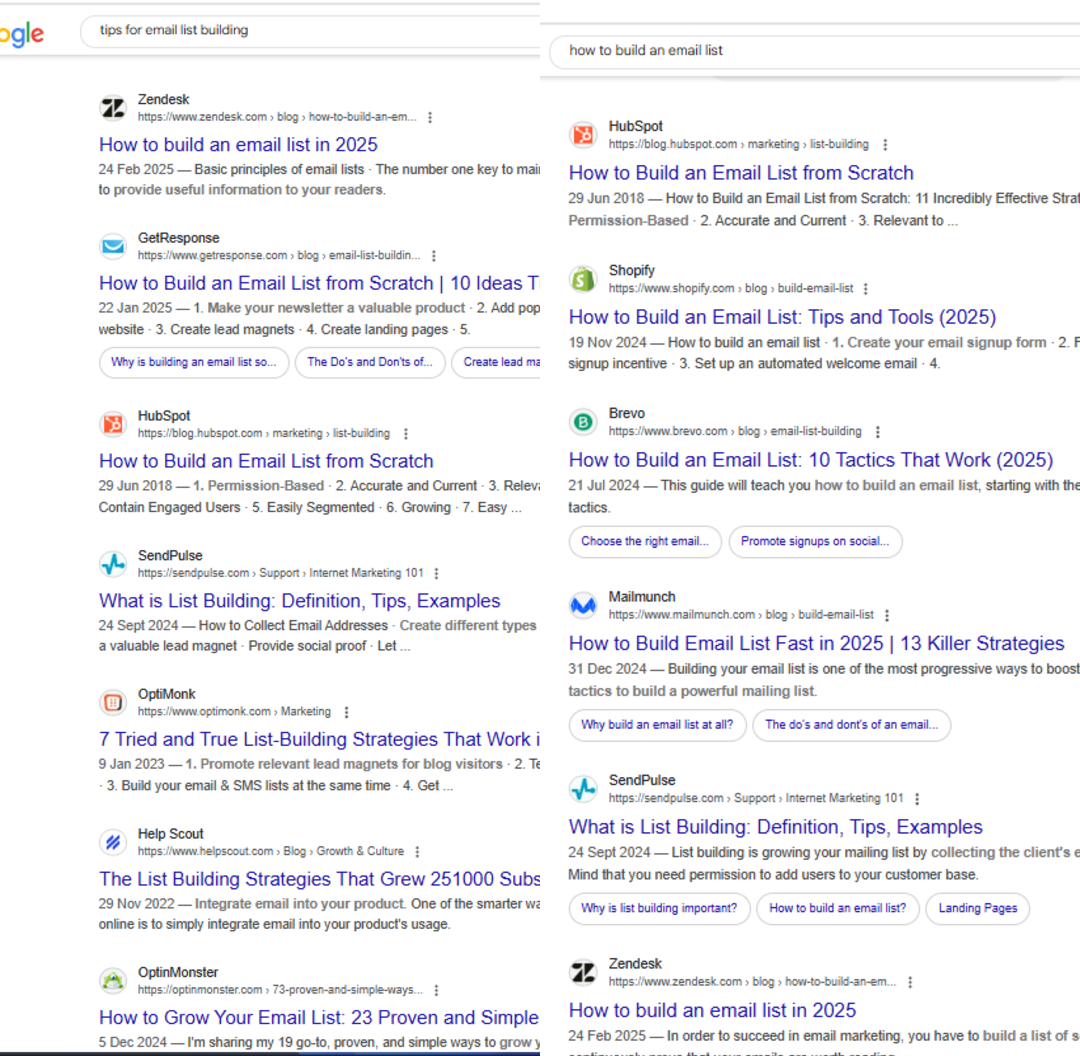
Instead of creating multiple identical pages, you can target the four keywords in one informational piece that covers all the essentials for building a successful email list.
This is what keyword clustering is all about.
What are the Benefits of Keyword Clustering in SEO?
At this point, I’m sure you’re wondering: What’s so bad about writing four different blog posts instead of one longer piece? After all, aren’t four heads better than one? Well, in this case, no, and here are four reasons why:
Prevents Keyword Cannibalization
One benefit of clustering your keywords is that it helps you avoid keyword cannibalization. This is when multiple pages on your website are optimized for the same search query. In this case, Google doesn’t know which one to rank and eventually decides that neither gets their share of the traffic.
So, rather than competing with external websites, you compete with yourself, sabotaging your shot at getting discovered.
That’s why keyword clustering is your knight in shining armor. It groups all related keywords, so only one page on your site is optimized for these similar search terms. This eliminates internal competition and positions you to rank better on SERPs.
Improves Content Relevance and Site Authority
Keyword clustering helps you create in-depth pieces of content around a topic. Using our initial keyword examples, if you craft individual pages for each, you simply have a collection of half-baked blog posts that highlight just a teeny bit of what goes into building an email list.
But by grouping all these keywords in a single cluster, our findings are condensed into one article, making for a richer, more relevant piece.
Filling your blog with multiple blog posts with this strategy is what establishes you as a thought leader in your industry.
Brands like Hubspot, for instance, are experts at keyword clustering, which is why when you’re looking for information about marketing, customer service, or CRM, you instantly head to their site.
You can equally do the same to become a resource hub in your niche, whether it’s SaaS, healthcare, food, and beyond.
Improves the User Experience
Have you ever scoured through multiple web pages before you found a thorough explanation of what you were searching for? Now, that wasn’t fun, was it?
Wouldn’t it have been nice to find one piece that answered all your questions in one go?
That’s what keyword clustering does for your readers.
When you create comprehensive blog posts following a keyword cluster, visitors won’t need to bounce off your site. All their questions are answered in-depth, improving the user experience.
I don’t think I’ve ever read a Hubspot article that left me tunneling through the SERPs for more information. Our Nightwatch blog does the same, as each piece is crafted to thoroughly cover every query you might have on a topic. You’re welcome.
Improves Search Engine Rankings and Organic traffic
When Google recognizes that your blog post is the most valuable resource on a subject, it will rank it above the others. Why? Because Google prioritizes the user’s experience and only ranks pages that do the same.
Maximizing the number of terms you rank for through keyword clusters helps you create content that addresses multiple related search queries, leaving readers satisfied.
Google has mentioned that this is exactly the type of content it finds rank-worthy in its creating helpful, reliable, people-first guide: all-in-one resources that don’t leave readers with the urge to consult other sources.
This will improve your rankings and drive organic traffic and leads to your site.
What are the Types of Keyword Clusters?
There are different ways you can group keywords into cohesive clusters. You can achieve this based on shared search intent, similarity in meaning, or through the SERPs.
Search Intent Clustering
With this type of keyword clustering, you group your keyword list based on their shared search intent.
Search intent is the end goal of any search engine user’s query. It is what folks hope to achieve when they pop a question into Google.
There are essentially four types of search intent you can categorize your keywords into:
- Informational: This is when searchers want to know more about a topic. Some examples include “What is a website title?” and “What is natural hair butter?”
- Navigational: Here, the user intends to visit a specific site like Wikipedia.com.
- Commercial: The user wishes to make a purchase and wants to learn more about the available options. Some examples are “Top Books Worth Reading in 2025”, “Best Coffee Makers for Busy Homeowners”, and so on.
- Transactional: This is when the user has weighed available options and is finally ready to buy. A good example is “buy RevAir blowdryer”.
With this method, search terms with the same intent form a single cluster, and you would create a single piece of content targeting all those keywords.
For instance, keywords like “top natural hair conditioners” and “the best natural hair conditioners” share similar commercial intent and can be grouped into one cluster.
A combination like “DIY conditioner recipe” and “top hair care conditioners” would not fit into the same cluster as they have different user intents.
Semantic Clustering
This involves grouping keywords based on their perceived sameness in meaning. All these keywords, for instance, mean the same thing; they’re just phrased differently:
- Buy running shoes
- Purchase jogging sneakers
- Best running shoes to buy
- Order running footwear online
SERP Clustering
SERP clustering is an SEO strategy where keywords are grouped based on their similarity in search engine results pages or SERPs. While writing this article, for instance, I found a few keywords related to this topic:
- What is keyword clustering?
- Keyword clustering
- SERP clustering
- What is a keyword cluster?
While these are different keywords, they triggered the same results page.
I instantly understood they were a cluster and would be most suited for a single blog post. That’s why we have a definition of keyword clustering, SERP clustering, and keyword clusters within this article instead of on separate pages.
What Keyword Clustering Method Should You Use?
The smart approach is to combine all three methods. Relying on just one might rob your site of vital ranking potential, as you may wrongly cluster your keywords.
The keywords “online marketing” and “digital marketing”, for instance, have similar meanings but slightly different SERPs. So, it’s a good idea to create different pieces of content for each search query.
As you’re more likely to make this mistake when relying solely on semantic and intent clustering, double-check your findings with the search results. They probably belong on the same page if they have the same SERPs. If not, separate articles are the way to go.
How to do Keyword Clustering Fast and Easy
Now that you know what keyword clustering is and the types of clusters available, it’s time to create your first keyword group.
In this example, we’ll assume the role of marketers for a natural hair care brand looking to generate rank-worthy content ideas for its blog.
Let’s go!
Conduct Keyword Research
Before you even think about clustering, you need to find keywords relevant to your niche and target audience.
You can do this manually or with SEO tools like Nightwatch.
Manual Keyword Research
On the manual route, start with Google’s Autosuggest. This feature uses predictive analysis to complete or predict search queries automatically.
While this was primarily meant to help search engine users save time, it’s a smart way to find keywords your target audience is actively searching for. Just remember to do this incognito to prevent your search history from influencing the suggestions.
I tried this with “natural hairstyles” and got suggestions like “natural hairstyles for ladies,” “natural hairstyles for kids,” and more.
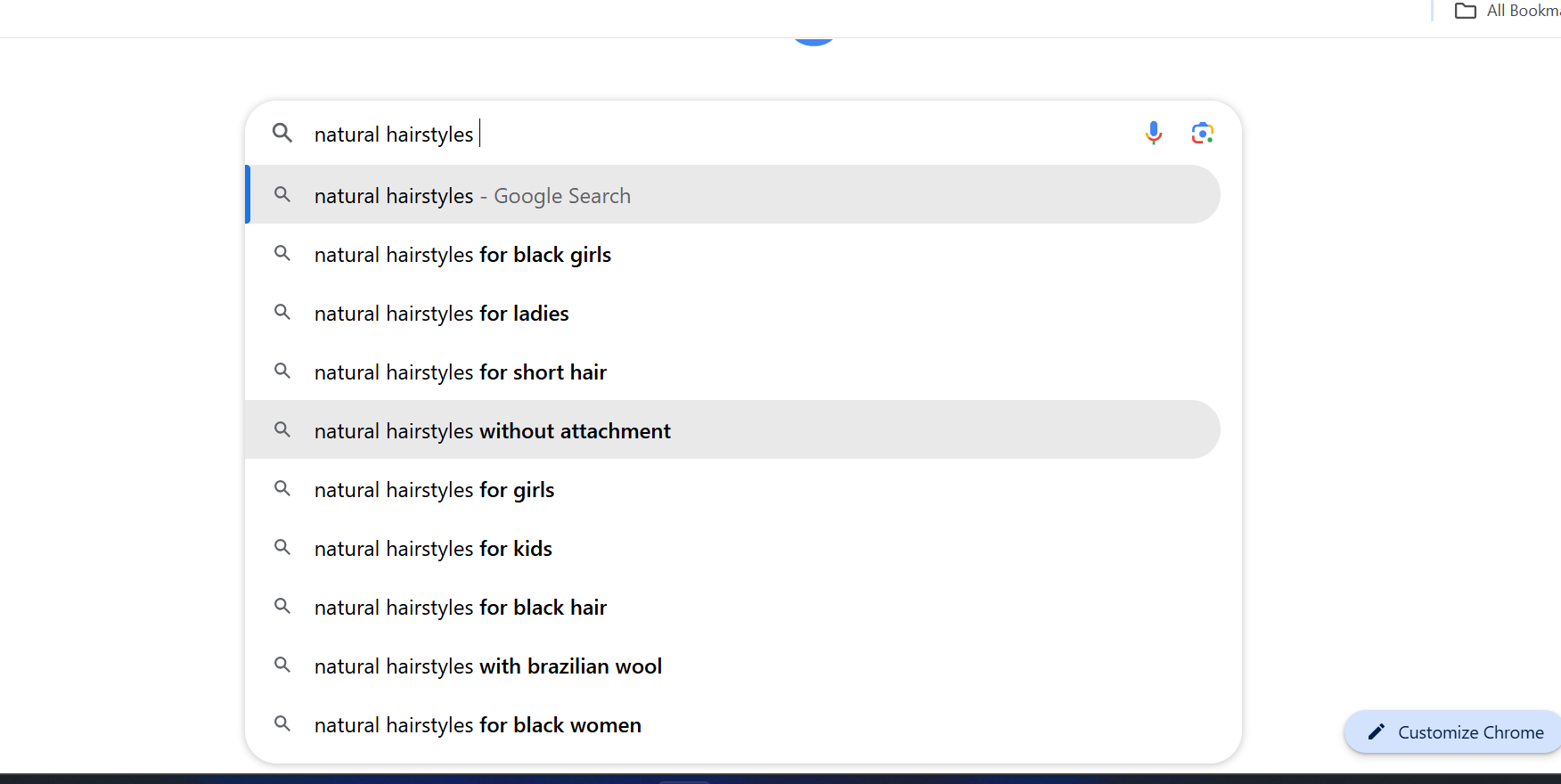
And when you scroll on the SERP page, you’ll find even more keywords in the people also asked and related searches section.
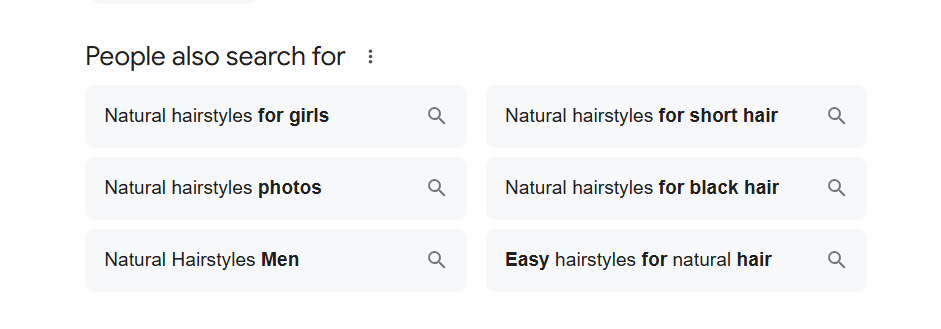
Finally, collate all the keywords into a spreadsheet.
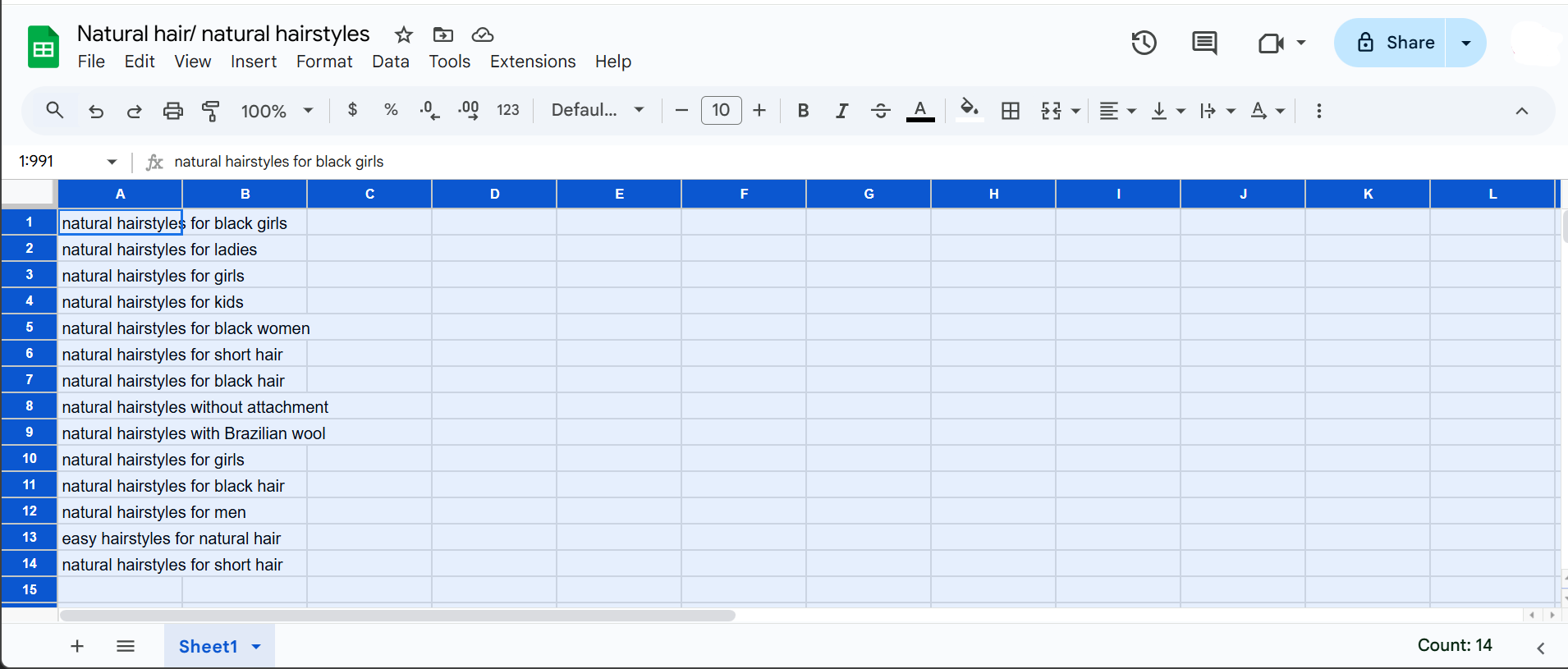
Keyword Research With a tool
To hasten this process, consider including an SEO tool like Google Keywords Planner or the Nightwatch keyword research tool. This will help you ascertain the SEO potential of your keywords through details like search volume, keyword difficulty, and cost per click.
-
First, visit research.nightwatch.io
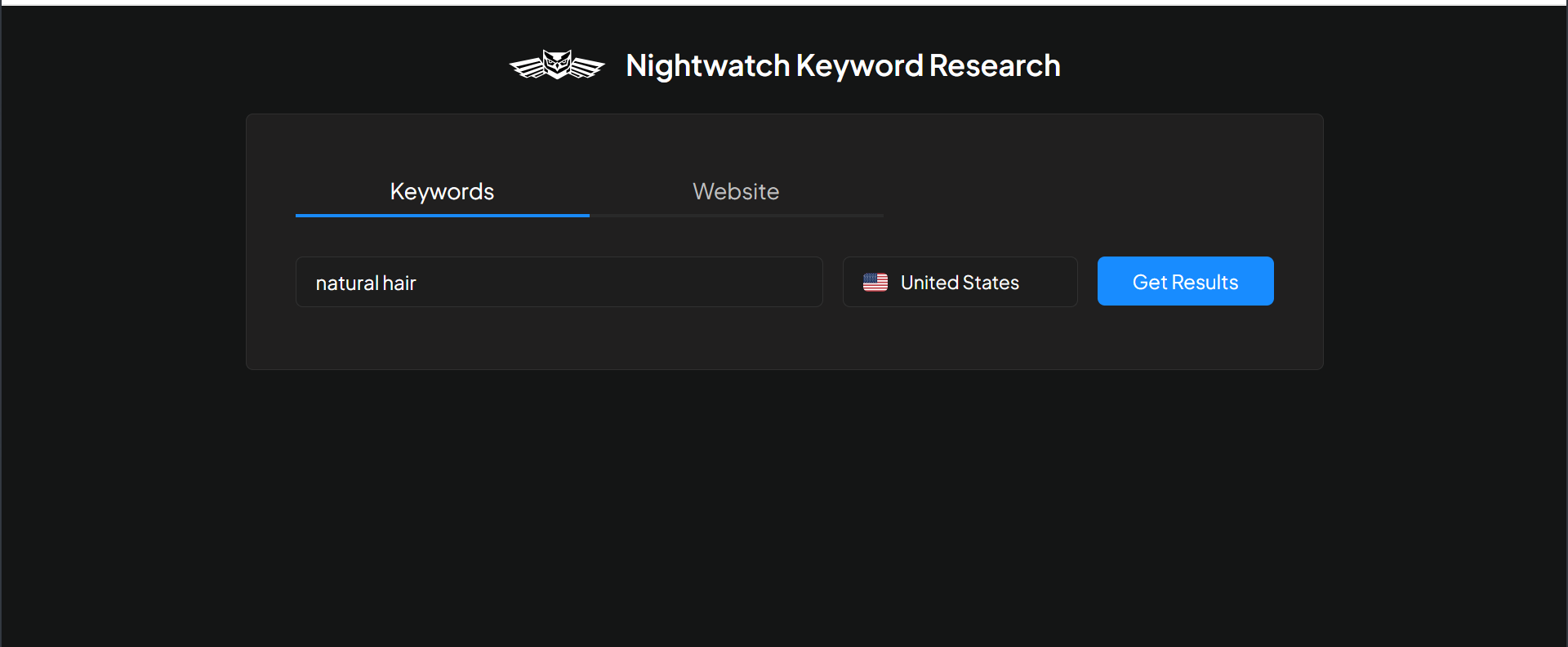
-
Type in your website or a keyword and provide your email address.
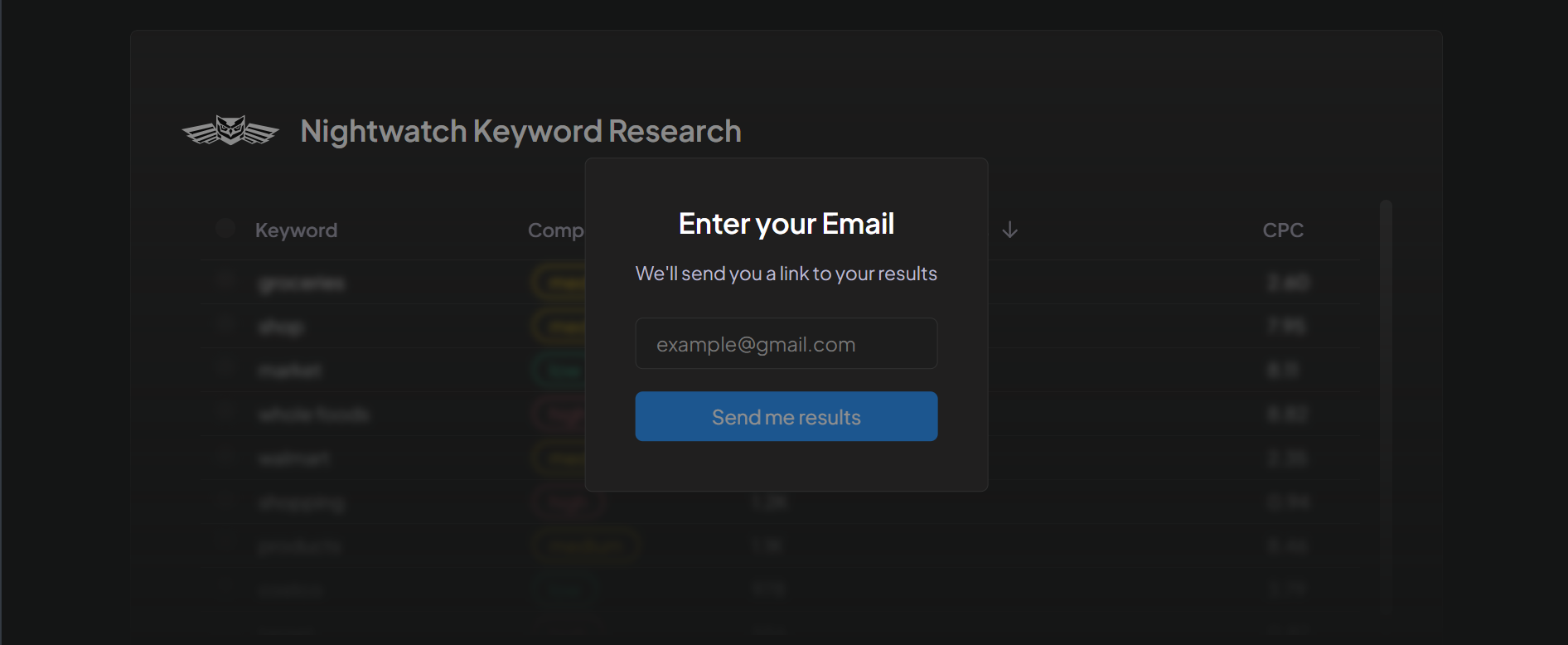
- And you’ll receive a list of relevant search queries right in your inbox.
Our AI SEO agent makes this more interactive. You simply ask the AI to find relevant keywords in your niche, and it will instantly generate keywords, their search volume, and their difficulty.
Here’s what I got for “natural hairstyles”:
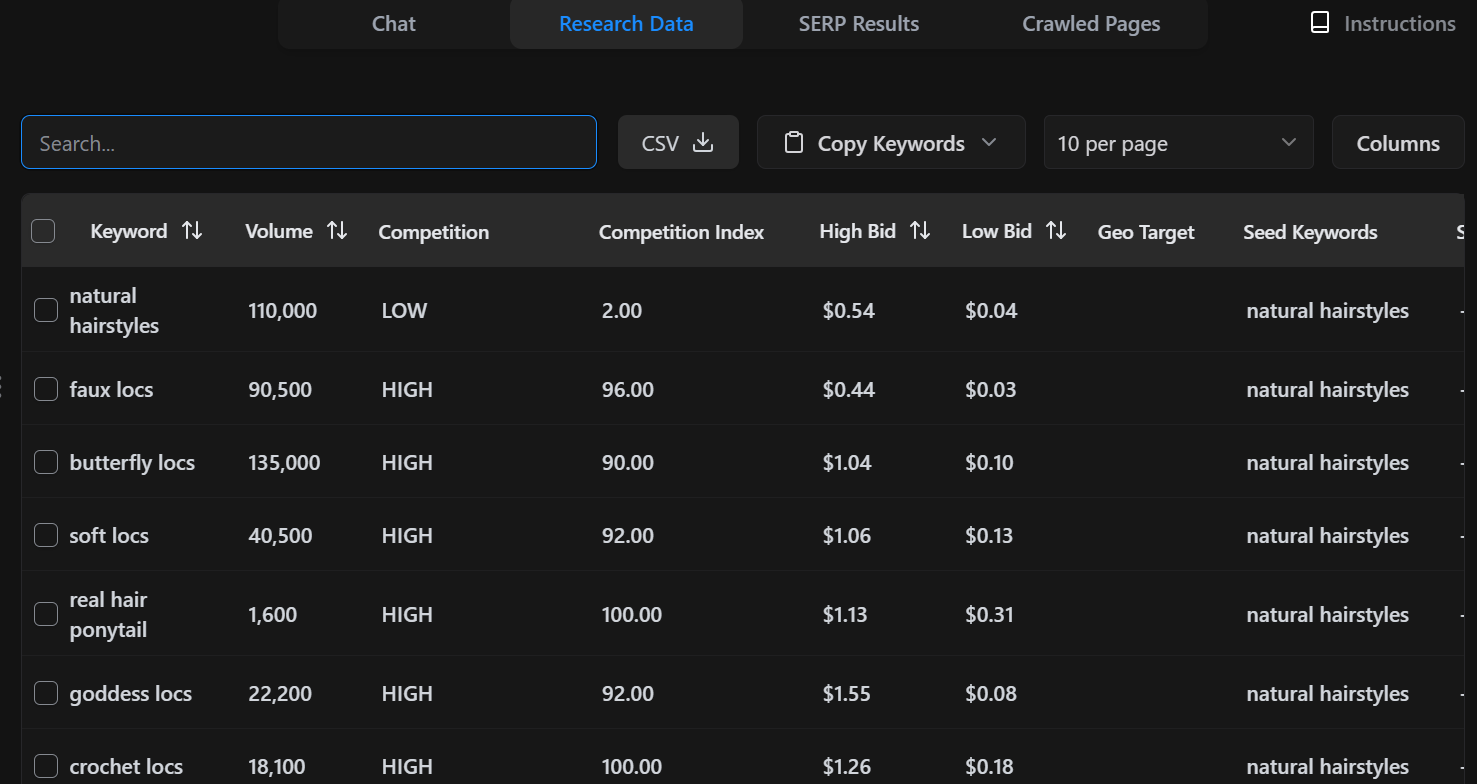
Once you’ve compiled a decent list of keywords in your spreadsheet, proceed to the next step.
Organize Your Keywords into Clusters
Now, you’re probably overwhelmed by the number of keywords you have. Well, don’t be. Once we’re done organizing, you’ll discover that many of these terms share the same intent and should be in the same cluster.
Manual Clustering
This is the hard part.
You will have to manually type each into Google’s search bar and indicate in separate columns on your spreadsheet what intent and SERP page they fall into. This is called SERP analysis.
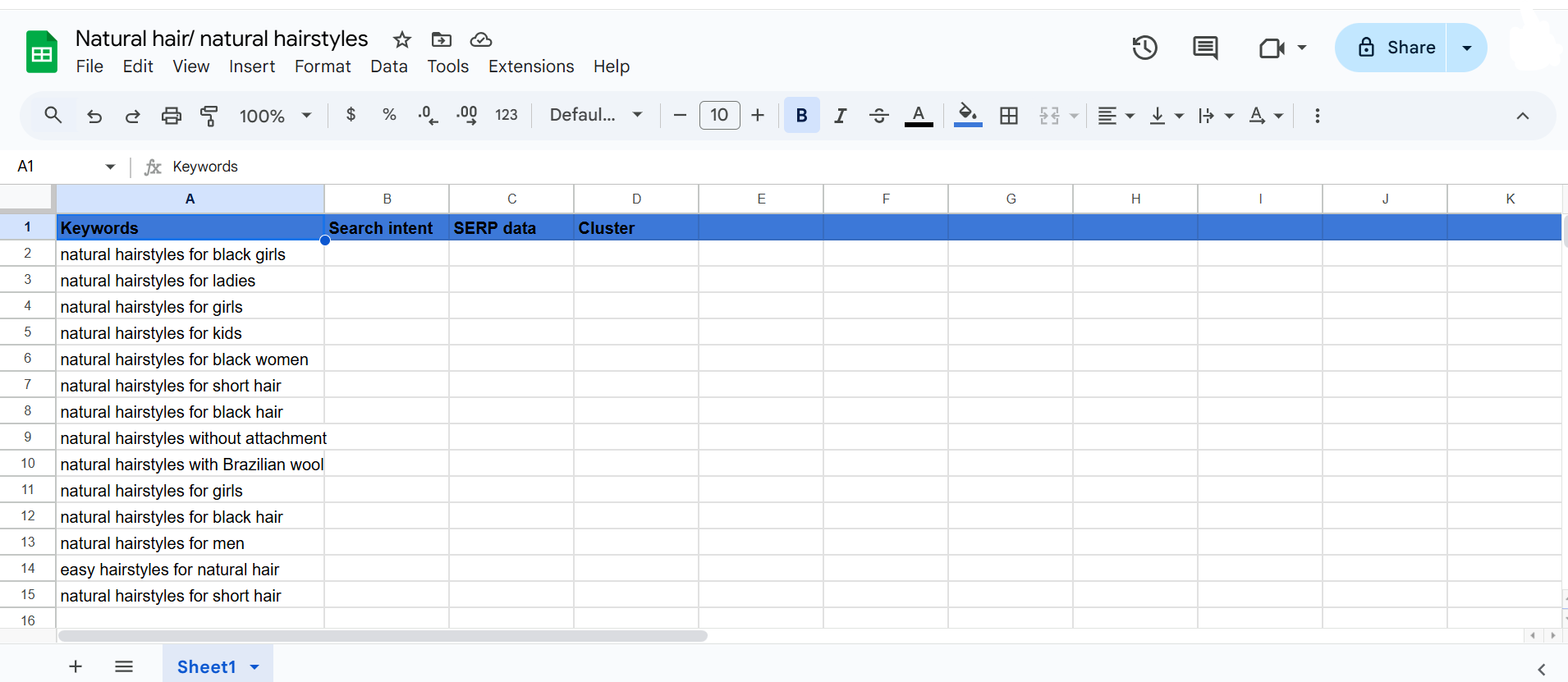
For instance, when I searched for “medium-length natural hairstyles” and “shoulder-length natural hairstyles,” I discovered that their SERP and intent overlapped. So, I would include them in the same cluster.
Clustering with an SEO tool
Since manually analyzing your keywords can become time-consuming, let’s try the SEO agent instead.
- Log in to your SEO agent account
- Prompt the AI to cluster your keywords based on SERP and intent similarity.
- Paste your keywords and let the AI do its thing.
- Or perform your research from scratch here and tell the AI to generate and cluster the keywords.
Here’s a simple prompt you can use:
Make a keyword research for the keyword “natural hairstyles” and group the keywords into keyword clusters
And this is how it turned out:
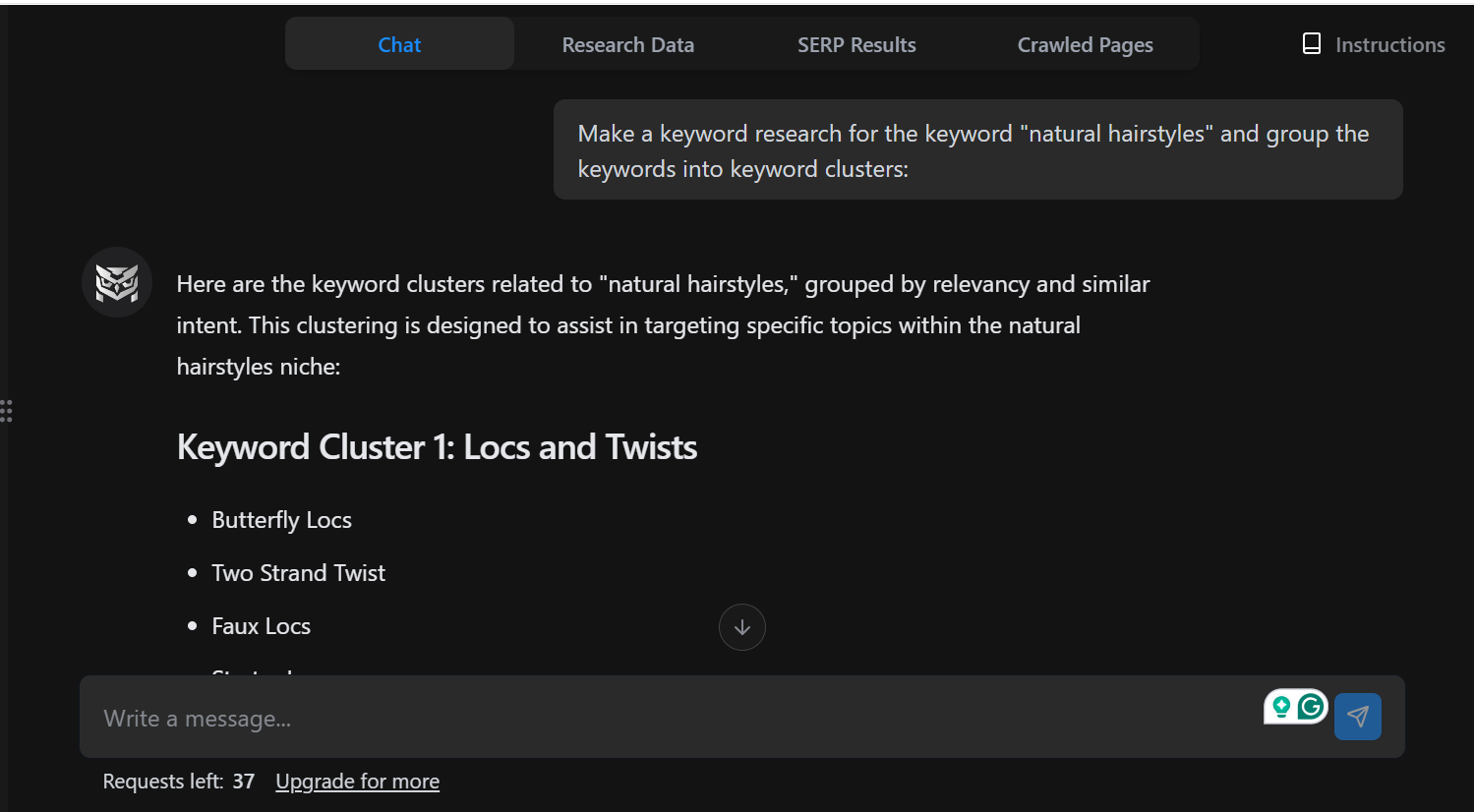
It will automatically organize your keywords into distinct groups and even give you additional information on how to group them into topic clusters and craft your content for optimal performance.
Create SEO-friendly Content
After compiling a cluster, the next thing is to craft an SEO-friendly article targeting these keywords.
Here are some things you should prioritize:
-
Readability: The best writing advice is to write as though you’re talking to a friend or your mom. Avoid complex or formal words and sentences.
Write in shorter paragraphs of two to three sentences. This makes your content easy on the eyes and easier to skim.
-
Clear formatting: Your articles must each have one H1 tag and several H2s and H3s. This makes it easier for readers and search engines to follow the logical sequence of your work.
Also, use bullet points, italics, and bold to highlight important information.
-
Depth: All the questions your keywords pose must be thoroughly answered in your article. Ask yourself. “Will my audience have additional questions after reading this?” “Is anything unclear or poorly presented?” If so, the article might need some rewriting.
-
Focus on your Intro: It sounds cliche, but your introductory paragraph can encourage your readers to stick around or bounce. So, engage your readers in the first few sentences by sympathizing with their challenges and urging them to read your article for solutions.
-
Keyword placement: Place your primary keyword in the H1, the first 100 words, the meta title, and the meta description. Also, include secondary keywords in your subsections and sparingly throughout your content to avoid keyword stuffing.
-
Meta data limit: To prevent your meta title and description from being cut off on SERPs, limit them to 60 and 150 characters, respectively.
-
Linking: Include two to three internal and external links.
Again, if this process appears difficult for you or you’re not the best wordsmith out there, don’t worry. You can always prompt the SEO agent to craft high-quality articles based on the keyword clusters it generates.
It will help you save time and craft human-like, SEO-optimized content that ranks well on SERPs and satisfies your readers.
Track Your Performance
Publishing great content is just one step in the process. You’ll need to regularly update your articles to ensure their survival on the SERPs.
Tools like Google Search Console, Google Analytics, and Nightwatch can help you track the performance of your articles.
Once you sign in to Rank Tracker, the product tour prompts you to add your website, target keywords, and links to your competitors and select the country, region, search engine, and device you prefer to track.
For this, I chose Google and mobile.
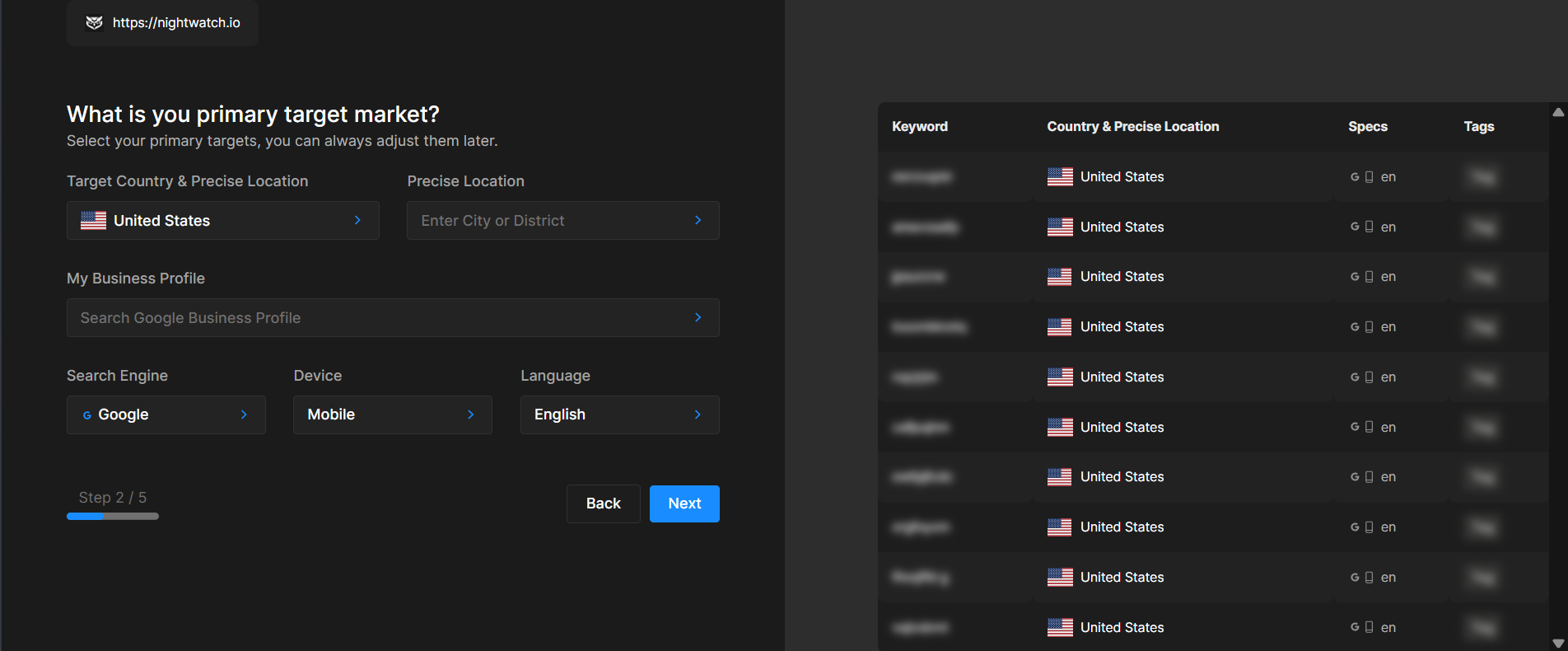
Once that’s complete, the dashboard will process your data before displaying your SERP performance, including your top-performing pages, average position, and more.
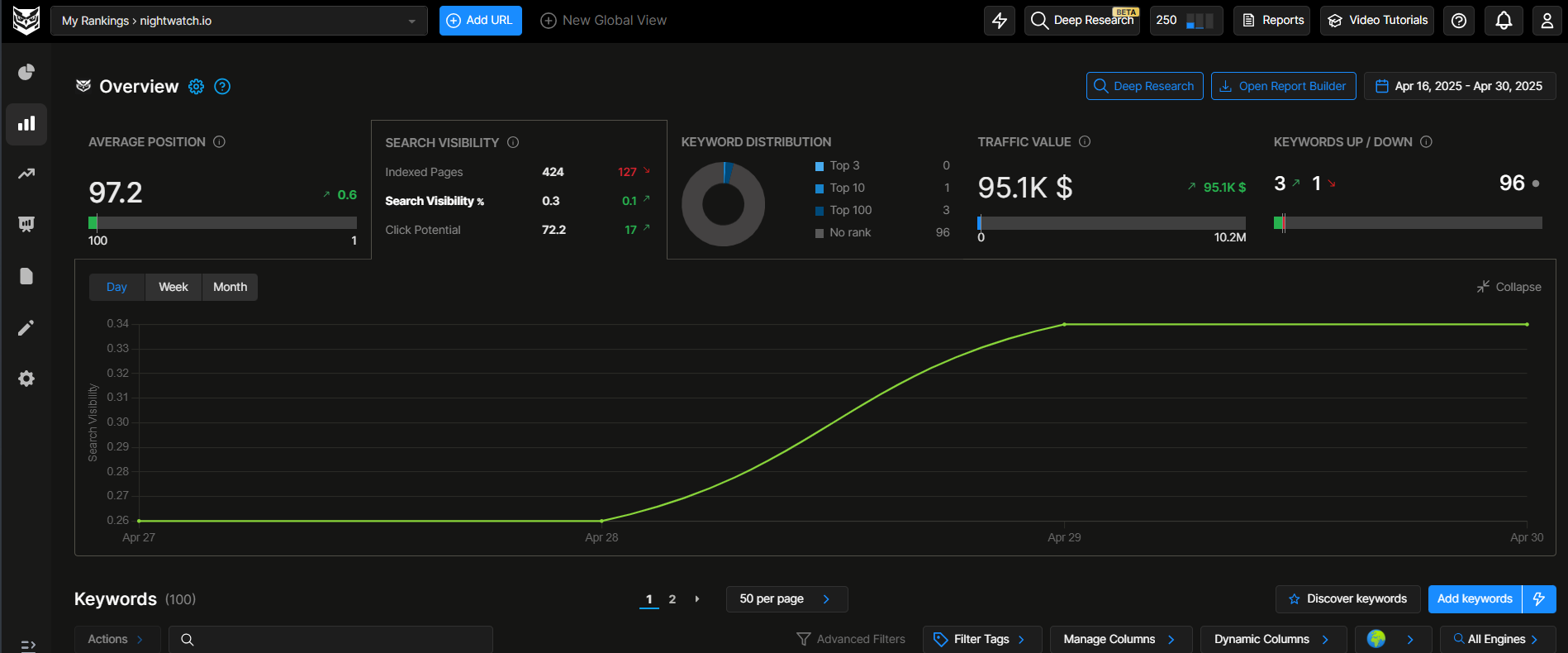
This data is also available in graphs to help you visually compare your performance to your competitors.
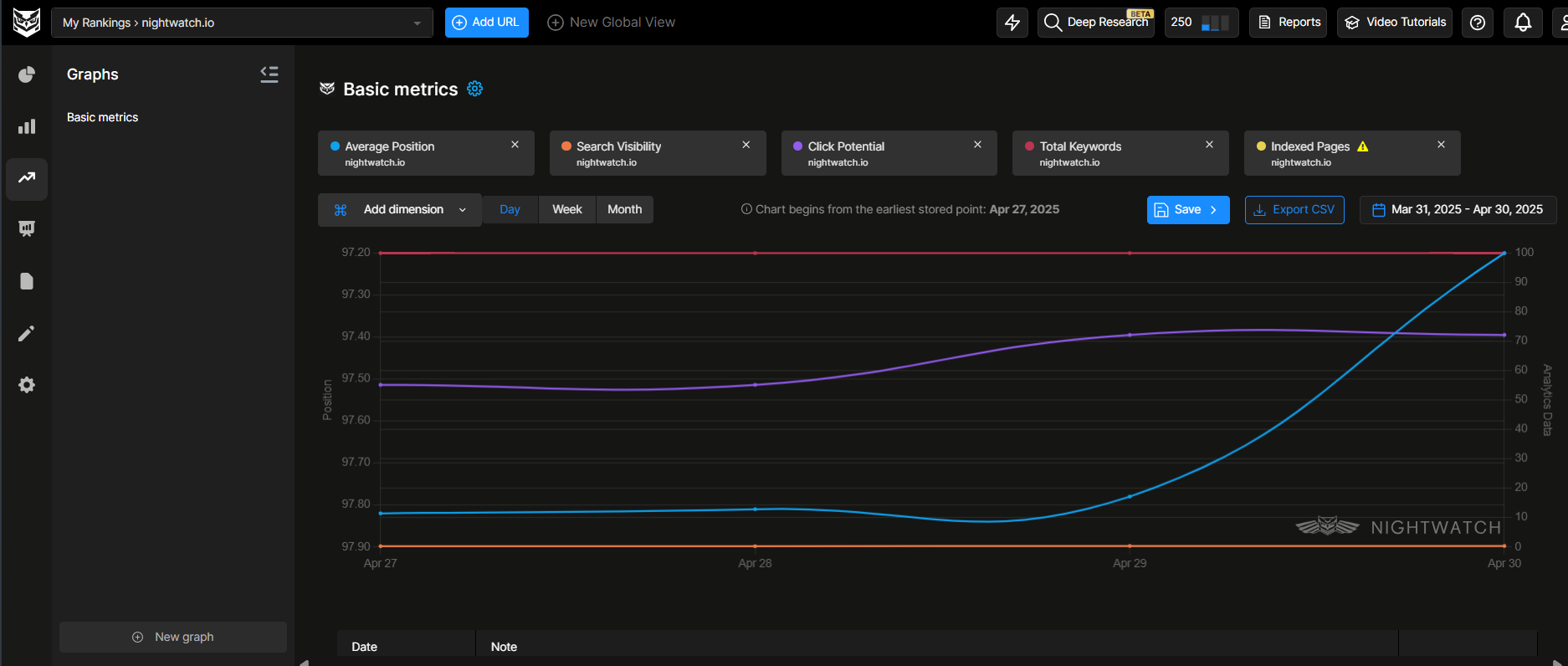
With our SEO agent, you can easily pinpoint underperforming articles, uncover what’s causing these lower rankings, and get actionable tips on rectifying the situation.
What’s the Difference between Keyword Clusters and Topic Clusters?
The first time you heard about keyword clusters, you may have confused them with topic clusters. Well, you’re not alone. It’s not uncommon to interchange these two aspects of SEO, yet they are different.
Simply put, a topic cluster is a cluster of keyword clusters. Don’t bite your tongue.
While keyword clusters are groups of similar keywords connected by meaning, intent, or SERPs, topic clusters are groups of closely related pages, all revolving around the same subject matter.
A keyword cluster is a central element that, along with other clusters, contributes to a larger site structure called a topic cluster.
Let’s illustrate this with some of the keywords from our previous research on natural hair.
- How to style natural hair at home without gel
- How to style natural hair at home with gel
- How to make your hair straight naturally, permanently
- How to keep natural hair straight in humidity
- When did the natural hair movement start
- Natural hair movement history
After analyzing them, you realize they can be grouped into three clusters.
One cluster contains keywords about styling natural hair with gel, the other focuses on straightening natural hair, and the last one provides unique into black hair history. These three clusters are essentially three blog posts or articles. But ultimately, they all talk about one thing—natural hair. At the broader level, these clusters form a topic cluster on “natural hair.”
This cluster will contain one in-depth guide called a pillar page, which every other page in the cluster links to.
Together, keyword and topic clusters give your content a logical, hierarchical structure, which makes it easy for Google to understand what your blog is all about and what you want to be known for.
Rather than publishing random articles, create multiple in-depth pieces to give your site topical authority on that subject.
Common Keyword Clustering Mistakes and How to Avoid Them
Keyword clustering is a great SEO strategy for creating impactful content and building your site’s authority. But one wrong move and all your efforts could go to waste. Let’s look at some wrong moves and how you can easily avoid them to maximize your strategy.
Clustering By Exact Word Match
Many SEO beginners mistakenly cluster keywords based on similarity in phrasing rather than a shared search intent or result’s page. You might discover a list of terms with identical words and assume they are variations of the same queries. This results in a blog post that targets multiple search intents, confuses search engines, and is nowhere to be found on SERPs.
If you’re working on a painting blog, you might wrongly lump these keywords together simply because they have the words “acrylic paint” in them:
- Best Acrylic paints for beginners
- How to clean dried acrylic paint off brushes
In reality, these are unique keywords that need separate pages. When I conducted a SERP analysis, I saw that each produced different results. A mistake like this will cause a mismatch between your page and user intent.
Here’s how to avoid it:
- Always analyze the SERP results of your keywords. Study what types of pages rank for individual keywords and group those with the same results. If the SERPs vary, the keywords belong to different clusters.
- Understand what searchers want before writing your blog post. You can easily recognize this by examining the top search results of each keyword. If all the pages are informational, the keyword is informational as well.
Our keyword tool makes this process much easier by automatically highlighting the user intent of each keyword.
Creating Too Many Small Clusters
Another mistake is attributing only a few keywords to a page, resulting in underdeveloped pieces. This can harm your rankings as Google prioritizes detailed, comprehensive content that serves as a thorough resource on a topic.
The solution is to think in terms of relevant blog topics or ideas. Discover all keywords related to that topic and create optimized content to rank for them.
If you’re writing an article about acrylic paints, naturally, you need to define them, discuss how they’re formed, and how to use them. Missing any essential section by targeting a limited list of keywords is a recipe for lower rankings.
Ignoring Keyword Volume and Difficulty
While creating keyword clusters, you must answer two critical questions: How many people are interested in this topic, and how difficult will it be to rank for it?
No matter how effective keyword clustering is, it still depends on crafting content around keywords with decent keyword volumes and difficulties before you can drive traffic to your site.
To avoid this, you can use our keyword research tool to evaluate the search volume and difficulty of these keywords and only include the ones with decent numbers in your cluster.
Not Updating Clusters Over Time
Just like every other content strategy, keyword clustering requires constant monitoring, refinement, and updates to produce the best results. Search behavior evolves, as do Google’s algorithms.
Sometimes, you’ll need to add new keywords to a cluster to improve its value, or Google might start interpreting a query’s search intent differently. So, if your clusters stay frozen, your content strategy becomes outdated.
That’s why it’s important to:
- Reaudit your keyword clusters every 3 to 6 months.
- Monitor your content’s performance and adjust when queries shift and rankings dip.
- Use tools like Google Search Console or Nightwatch’s Rank Tracker to discover what queries bring in the most traffic and optimize or re-cluster based on that data.
Your Competitors are Using Keyword Clustering. When Will You?
Keyword clustering is a powerful content strategy that helps you create rank-worthy content. If you’re not utilizing it yet, there’s a good chance your competitors are.
That’s why their blog posts always snatch the shiny top spot on SERPs while your pages consistently stay buried on the second page. Sorry.
To compete effectively, you can adopt the same strategy and beat them at their own game.
Rather than publish several half-baked pieces, target multiple keywords within a cluster and create impactful resources that will satisfy readers and convince Google that your content is worth ranking above the rest.
